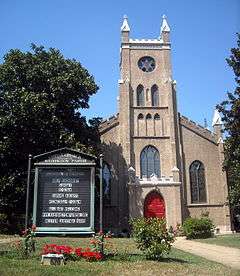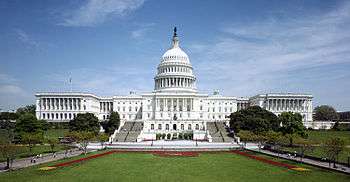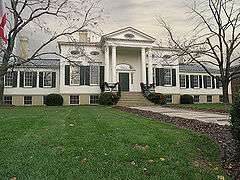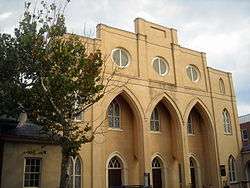List of works by Benjamin Henry Latrobe
Works by Benjamin Henry Latrobe, a British-born architect, were influenced by Greek Revival styles and those of British architect John Soane. Latrobe emigrated to the United States, living initially in Virginia, then in Philadelphia, before being hired to work on government projects in Washington, D.C. His works most notably included the United States Capitol, along with designing the porticoes of the White House. He also designed numerous houses and other buildings.
Latrobe worked on various engineering projects, as well, including the Philadelphia waterworks, along with projects in New Orleans where he spent the last years of his life. He wrote quite a bit, including extensive notes in his journals, which have since been published, and he translated works by others.
Architecture
Latrobe's many architectural works include:
| Work | Place | Year | Notes | Image |
|---|---|---|---|---|
| Hammerwood Park | East Grinstead, UK | 1792 |  | |
| Ashdown House | East Sussex, UK | 1793 | ||
| William Pennock House | Norfolk, Virginia | 1796 | [1][2] | |
| Richmond Penitentiary | Richmond, Virginia | 1797–1798 | [3] | |
| Gamble Hill (Col. John Harvie's home) | Richmond | 1798 | [4] | |
| Bank of Pennsylvania | Philadelphia | 1798–1801 | First major Greek Revival building in the United States. |  |
| Sedgeley | Philadelphia | 1799–1802 | Built for William Cramond on the Schuylkill River, but the mansion fell into disrepair after 1836 when it was subdivided. It was demolished in 1857, and the land is now part of Fairmount Park. A tenant's cottage build along with the mansion remains in existence — the cottage is the only remaining building in Philadelphia designed by Latrobe.[5] |  |
| Sansom's Buildings | Philadelphia | 1800–1801 | with Thomas Carstairs | |
| Edward Shippen Burd House | Philadelphia | 1801–1802 | Located at Chestnut and 9th Street; Architectural characteristics similar to the Admiralty House in London, designed by Samuel Pepys Cockerell.[6] | |
| Nassau Hall | Princeton, New Jersey | 1802 | Originally designed by Robert Smith, and for a period in 1783, it hosted the Congress of the Confederation. The building was later redesigned by Latrobe, after a fire destroyed the building, though it was destroyed once again by fire in 1855 and rebuilt by Philadelphia architect John Notman.[7] | |
| Stanhope Hall | Princeton, New Jersey | 1803 | The third building of Princeton University's campus and originally home to the library, study halls, and literary societies. Later known as "Geological Hall," in 1915 it was named in honor of Samuel Stanhope Smith, president of the university at the time of its construction.[8] | |
| Basilica of the National Shrine of the Assumption of the Blessed Virgin Mary | Baltimore | 1806–1821 | First Catholic Cathedral built in the United States |  |
| Waln House | Philadelphia | 1807–1808 | ||
| Clifton House | Richmond, Virginia | 1808 | Built for Benjamin James Harris, the house featured squarish-dimensions and a central, multi-story hall with a cupola to provide lighting.[9] | |
| Markoe House | Philadelphia | 1808–1811 | Built for John Markoe, who later sold it and it was used as a boarding house until the 1880s when it was demolished.[10] | |
| Long Branch | Millwood, Virginia | 1811 | Built for Robert Carter Burwell[11] | |
| Portico of Belleview | Washington, D.C. | 1813 | ||
| Ashland | Lexington, Kentucky | 1813 | Built two wings onto the home. | |
| Brentwood | Washington, D.C. | 1817 | Florida Avenue and 6th St NE; Destroyed by fire in 1917[12] | |
| Van Ness House | Washington, D.C. | 1813–1818 | Later demolished[13] | |
| Christ Church | Washington, D.C. | 1807 | The building used by the city's first Episcopal parish was designed in the Gothic Revival style.[14] |  |
| Decatur House | Washington, D.C. | 1818 | Located on Jackson Place[15] | |
| United States Capitol | Washington, D.C. | Central portion only, including original low dome |  | |
| Davidge Hall | Baltimore | The building known today as Davidge Hall, completed in 1812, is part of the University of Maryland School of Medicine. It is the oldest building in the Northern Hemisphere in continuous use for medical education.[16] | .jpg) | |
| University of Pennsylvania Medical School | Philadelphia | Designed in collaboration with his apprentice, William Strickland; Demolished in 1874.[17] | ||
| Pope Villa | Lexington, Kentucky | 1811–1812 | 326 Grosvenor Avenue; The house was the first to incorporate an English basement.[18] | |
| Adena Mansion | Chillicothe, Ohio | 1806 | | |
| Taft Museum of Art | Cincinnati | 1820 | Originally the home of Martin Baum |  |
| St. John's Church | Washington, D.C. | 1816 | [15] | |
| St. Paul's Church | Alexandria, Virginia | 1818 | [19][20] |  |
| The White House east and west colonnades | Washington, D.C. | Designed in collaboration with Thomas Jefferson, and north and south porticos, with James Hoban[21] | | |
| Latrobe Gate, Washington Navy Yard | Washington, D.C. | 1806 | Believed to be the oldest extant example of Greek Revival architecture in the United States.[22] |  |
| West College, or Old West at Dickinson College | Carlisle, Pennsylvania | 1803 | [23][24] |  |
| Belvidere | Belmont, New York | 1804 | Built in 1804 from plans attributed to Latrobe.[25] | .jpg) |
Writing
Benjamin Henry Latrobe authored several books and translated others, including:
- Characteristic Anecdotes ... to Illustrate the Character of Frederick the Great (1788)[26]
- Authentic Elucidation of the History of Counts Struensee [sic] and Brandt and of the Revolution in Denmark in the Year 1772 (1789)[26]
James Bruce hired Latrobe in 1790 to help put together Travels, a memoir of Bruce's journeys in Africa.[27][28]
After he arrived in the United States, Latrobe befriended Constantin-François Chassebœuf, comte de Volney, who stimulated an interest in geology. Latrobe kept numerous journals with geological notes and published a number of papers, including "Memoir on the Sand Hills of Cape Henry" (1799), Transactions of the American Philosophical Society (vol. 4, pp 439–44).[29]
Notes
- ↑ Hamlin 1955, p. 69
- ↑ Fazio 2006, pp. 210–221
- ↑ Hamlin 1955, pp. 120–126
- ↑ Hamlin 1955, pp. 99–100
- ↑ Westcott 1877, pp. 452–453
- ↑ Hamlin 1955, pp. 150–151
- ↑ "Nassau Hall". Princeton University. Retrieved 2009-01-24.
- ↑ Leitch, Alexander. "Stanhope Hall". Princeton University.
- ↑ Hamlin 1955, p. 103
- ↑ Fazio 2006, p. 354
- ↑ Hamlin 1955, pp. 111–115
- ↑ Goode 1979, p. 34
- ↑ Hamlin 1944, p. 32
- ↑ "Christ Church". National Park Service. Retrieved July 9, 2009.
- 1 2 Federal Writers' Project (1937). Washington, City and Capital: Federal Writers' Project. Works Progress Administration / United States Government Printing Office. p. 126.
- ↑ "About Davidge Hall". University of Maryland.
- ↑ Hamlin 1955, p. 16
- ↑ Hamlin 1955, p. 106
- ↑ Alexandria, VA - Historic Alexandria - Historic Preservation: Sites on the National Register of Historic Places
- ↑ St. Paul's Episcopal Church
- ↑ Fazio 2006, pp. 364–370
- ↑ "National Register of Historic Places Inventory - Nomination Form" (PDF). National Capital Planning Commission. National Park Service. June 30, 1972. Retrieved July 9, 2009.
- ↑ Norton 1951, pp. 125–132
- ↑ "West College - Old West". Dickenson College. Retrieved 2009-01-12.
- ↑ Robert Bromeley and Mrs. Patrick W. Harrington (August 1971). "National Register of Historic Places Registration: Belvidere". New York State Office of Parks, Recreation and Historic Preservation. Retrieved 2009-06-14. See also: "Unfiled NHL Nomination Form for Villa Belvidere". and "Accompanying five photos".
- 1 2 Hamlin 1955, p. 22
- ↑ Leask, Nigel (2002). "Curious Narrative and the Problem of Credit: James Bruce's Travels to Discover the Source of the Nile". Curiosity and the Aesthetics of Travel Writing, 1770-1840 (PDF). Oxford University Press. p. 65.
- ↑ Hamlin 1955, p. 26
- ↑ Hamlin 1955, p. 80
References
- Addison, Agnes (July 1942). "Latrobe vs. Strickland". The Journal of the Society of Architectural Historians. 2 (3): 26–29. doi:10.2307/901161.
- Burchard, John; Bush-Brown, Albert (1966). The Architecture of America: A Social and Cultural History. Little, Brown.
- Carter II, Edward C. (1971–1972). "Benjamin Henry Latrobe and the Growth and Development of Washington, 1798-1818". Records of the Columbia Historical Society.
- Donaldson, Gary A. (1987). "Bringing Water to the Crescent City: Benjamin Latrobe and the New Orleans Waterworks System". Louisiana History. Louisiana Historical Association. 28 (4): 381–396. PMID 11617566.
- Dumbauld, Edward (1980). "Thomas Jefferson and the City of Washington". Records of the Columbia Historical Society. 50.
- Fazio, Michael W.; Snadon, Patrick A. (2006). The Domestic Architecture of Benjamin Henry Latrobe. The Johns Hopkins University Press.
- Fazio, Michael W. (September 1989). "Benjamin Latrobe's Designs for a Lighthouse at the Mouth of the Mississippi River". The Journal of the Society of Architectural Historians. 48 (3): 232–247. doi:10.2307/990429. JSTOR 990429.
- Formwalt, Lee W. (1980). "Benjamin Henry Latrobe and the Development of Transportation in the District of Columbia, 1802-1817". Records of the Columbia Historical Society. 50.
- Formwalt, Lee W. (October 1977). "An English Immigrant Views American Society: Benjamin Henry Latrobe's Virginia Years, 1796-1798". The Virginia Magazine of History and Biography. Virginia Historical Society. 85 (4): 387–410.
- Formwalt, Lee W. (1979). "Benjamin Henry Latrobe and the Development of Internal Improvements in the New Republic, 1796-1820". Ayer Publishing / Catholic University of America.
- Frary, Ihna Thayer (1969). They Built the Capitol. Ayer Publishing. ISBN 0-8369-5089-5.
- Goode, James M. (1979). Capital Losses: A Cultural History of Washington's Destroyed Buildings. Smithsonian Institution Press. ISBN 0-87474-479-2.
- Hamlin, Talbot (1955). Benjamin Henry Latrobe. Oxford University Press.
- Hamlin, Talbot (1944). Greek Revival Architecture in America: Being an Account of Important Trends in American Architecture and American Life Prior to the War Between the States. Oxford University Press.
- Kennedy, Roger G. (1989). Orders from France: The Americans and the French in a Revolutionary World, 1780-1820. Alfred A. Knopf. ISBN 0-394-55592-9.
- Kimball, Fiske (1922). Domestic Architecture of the American Colonies and of the Early Republic. Charles Scribner's Sons.
- Latrobe, Benjamin Henry (1905). The Journal of Latrobe. D. Appleton & Company.
- Norton, Paul F. (June 1951). "Latrobe and Old West at Dickenson College". The Art Bulletin. 33 (2): 125–132. doi:10.2307/3047345. JSTOR 3047345.
- Norton, Paul F. (1977). Latrobe, Jefferson, and the National Capitol. Garland Pub. ISBN 0-8240-2716-7.
- Peterson, Charles E. (December 1953). "Early Prisons". The Journal of the Society of Architectural Historians. 12 (4): 26–31. doi:10.2307/987648.
- Stapleton, Darwin H.; Carter II, Edward C. (September 1984). ""I have the itch of Botany, of Chemistry, of Mathematics...strong upon me": the Science of Benjamin Henry Latrobe". Proceedings of the American Philosophical Society. American Philosophical Society. 128 (3): 173–192. PMID 11615972.
- Tatum, George B. (1961). Penn's Great Town: 250 Years of Philadelphia Architecture Illustrated in Prints and Drawings. University of Pennsylvania Press.
- Westcott, Thompson (1877). The Historic Mansions and Buildings of Philadelphia. Porter & Coates.